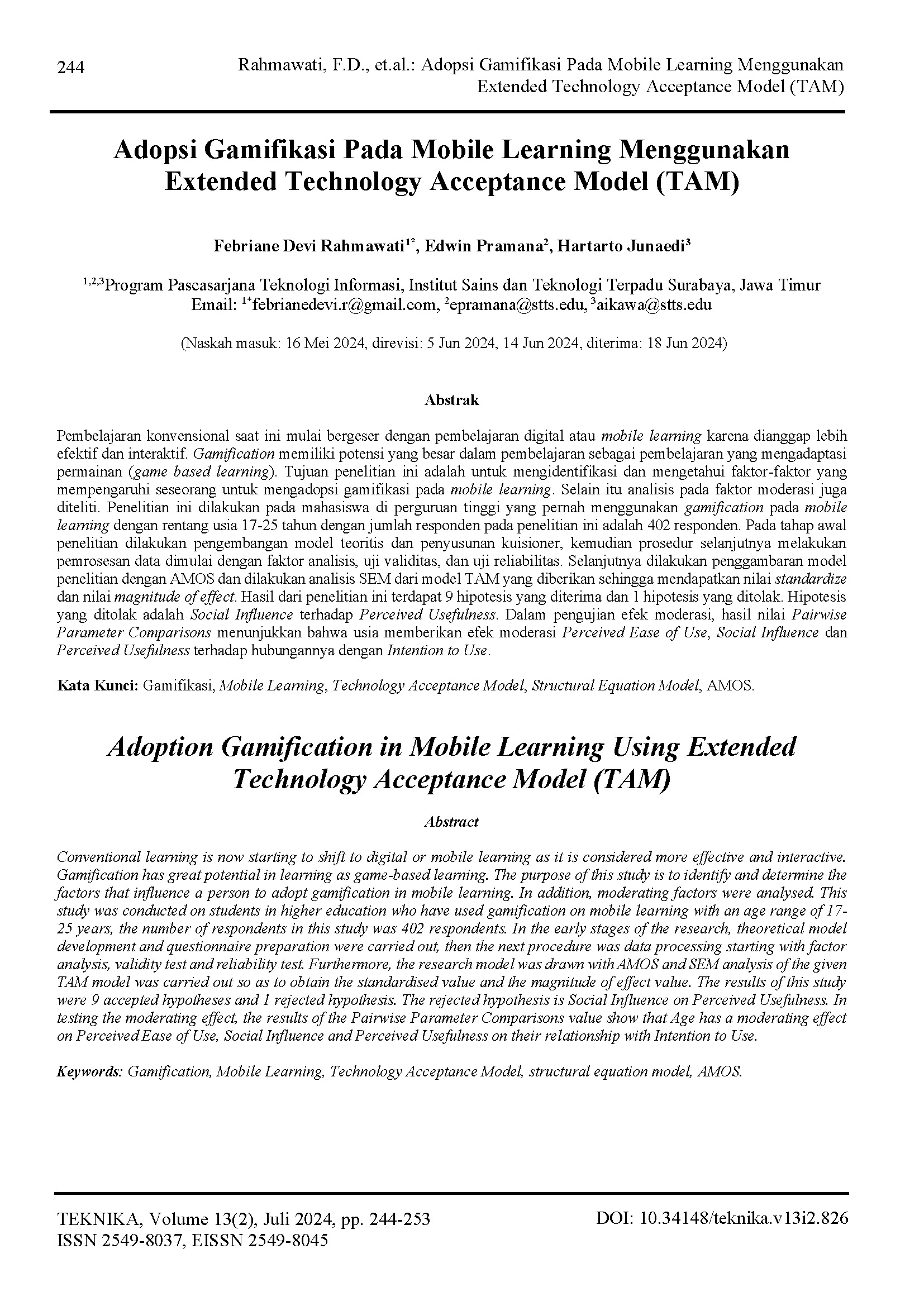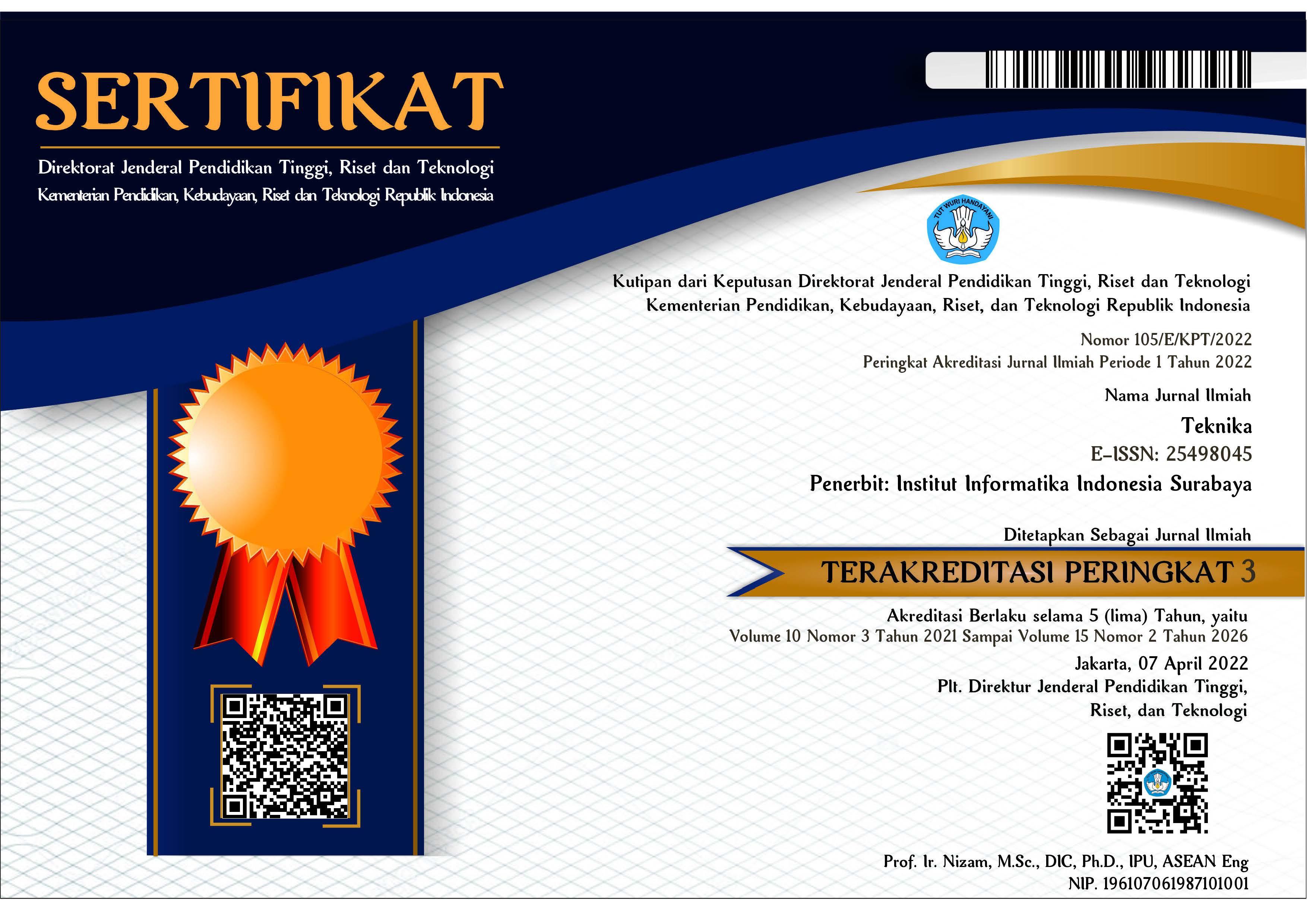Adopsi Gamifikasi Pada Mobile Learning Menggunakan Extended Technology Acceptance Model (TAM)
DOI:
https://doi.org/10.34148/teknika.v13i2.826Keywords:
Gamifikasi, Mobile Learning, Technology Acceptance Model, Structural Equation Model, AMOSAbstract
Pembelajaran konvensional saat ini mulai bergeser dengan pembelajaran digital atau mobile learning karena dianggap lebih efektif dan interaktif. Gamification memiliki potensi yang besar dalam pembelajaran sebagai pembelajaran yang mengadaptasi permainan (game based learning). Tujuan penelitian ini adalah untuk mengidentifikasi dan mengetahui faktor-faktor yang mempengaruhi seseorang untuk mengadopsi gamifikasi pada mobile learning. Selain itu analisis pada faktor moderasi juga diteliti. Penelitian ini dilakukan pada mahasiswa di perguruan tinggi yang pernah menggunakan gamification pada mobile learning dengan rentang usia 17-25 tahun dengan jumlah responden pada penelitian ini adalah 402 responden. Pada tahap awal penelitian dilakukan pengembangan model teoritis dan penyusunan kuisioner, kemudian prosedur selanjutnya melakukan pemrosesan data dimulai dengan faktor analisis, uji validitas, dan uji reliabilitas. Selanjutnya dilakukan penggambaran model penelitian dengan AMOS dan dilakukan analisis SEM dari model TAM yang diberikan sehingga mendapatkan nilai standardize dan nilai magnitude of effect. Hasil dari penelitian ini terdapat 9 hipotesis yang diterima dan 1 hipotesis yang ditolak. Hipotesis yang ditolak adalah Social Influence terhadap Perceived Usefulness. Dalam pengujian efek moderasi, hasil nilai Pairwise Parameter Comparisons menunjukkan bahwa usia memberikan efek moderasi Perceived Ease of Use, Social Influence dan Perceived Usefulness terhadap hubungannya dengan Intention to Use.
Downloads
References
L. F. Rodrigues, A. Oliveira, and C. J. Costa, “Playing seriously – How gamification and social cues influence bank customers to use gamified e-business applications,” Computers in Human Behavior, vol. 63, pp. 392–407, Oct. 2016, doi: 10.1016/j.chb.2016.05.063.
M. Denden, A. Tlili, M. Abed, A. Bozkurt, R. Huang, and D. Burgos, “To Use or Not to Use: Impact of Personality on the Intention of Using Gamified Learning Environments,” Electronics, vol. 11, no. 12, p. 1907, Jun. 2022, doi: 10.3390/electronics11121907.
Y. Luo and Z. Zheng, “Gamification and E-Learning Engagement Intention: An Empirical Study,” SSRN Journal, 2022, doi: 10.2139/ssrn.4006238.
M. Abou-Shouk and M. Soliman, “The impact of gamification adoption intention on brand awareness and loyalty in tourism: The mediating effect of customer engagement,” Journal of Destination Marketing & Management, vol. 20, p. 100559, Jun. 2021, doi: 10.1016/j.jdmm.2021.100559.
L. Aguiar-Castillo, L. Hernández-López, P. De Saá-Pérez, and R. Pérez-Jiménez, “Gamification as a motivation strategy for higher education students in tourism face-to-face learning,” Journal of Hospitality, Leisure, Sport & Tourism Education, vol. 27, p. 100267, Nov. 2020, doi: 10.1016/j.jhlste.2020.100267.
P. C. Lai and E. J. Y. Liew, “Towards a Cashless Society: The Effects of Perceived Convenience and Security on Gamified Mobile Payment Platform Adoption,” AJIS, vol. 25, Dec. 2021, doi: 10.3127/ajis.v25i0.2809.
A. García-Jurado, P. Castro-González, M. Torres-Jiménez, and A. L. Leal-Rodríguez, “Evaluating the role of gamification and flow in e-consumers: millennials versus generation X,” K, vol. 48, no. 6, pp. 1278–1300, Jun. 2019, doi: 10.1108/K-07-2018-0350.
S. Y. S. Hussain, W. H. Tan, and M. Z. Idris, “Digital Game-Based Learning for Remedial Mathematics Students: A New Teaching and Learning Approach in Malaysia,” in Proceedings of the Serious Games Conference 2014, Research Publishing Services, 2014, pp. 112–117. doi: 10.3850/978-981-09-0463-0_011.
M. N. Masrek and I. Samadi, “Determinants of mobile learning adoption in higher education setting,” Asian Journal of Scientific Research, vol. 10, pp. 60–69, 2017.
F. D. Davis, “Perceived Usefulness, Perceived Ease of Use, and User Acceptance of Information Technology,” MIS Quarterly, vol. 13, no. 3, p. 319, Sep. 1989, doi: 10.2307/249008.
P. Raman, “Examining the importance of gamification, social interaction and perceived enjoyment among young female online buyers in India,” YC, vol. 22, no. 3, pp. 387–412, Jul. 2021, doi: 10.1108/YC-05-2020-1148.
R. Algesheimer, U. M. Dholakia, and A. Herrmann, “The Social Influence of Brand Community: Evidence from European Car Clubs,” Journal of Marketing, vol. 69, no. 3, pp. 19–34, Jul. 2005, doi: 10.1509/jmkg.69.3.19.66363.
P. Bitrián, I. Buil, and S. Catalán, “Enhancing user engagement: The role of gamification in mobile apps,” Journal of Business Research, vol. 132, pp. 170–185, Aug. 2021, doi: 10.1016/j.jbusres.2021.04.028.
J.-W. Moon and Y.-G. Kim, “Extending the TAM for a World-Wide-Web context,” Information & Management, vol. 38, no. 4, pp. 217–230, Feb. 2001, doi: 10.1016/S0378-7206(00)00061-6.
A. Aebli, “Tourists’ motives for gamified technology use,” Annals of Tourism Research, vol. 78, p. 102753, Sep. 2019, doi: 10.1016/j.annals.2019.102753.
R. Scherer, F. Siddiq, and J. Tondeur, “The technology acceptance model (TAM): A meta-analytic structural equation modeling approach to explaining teachers’ adoption of digital technology in education,” Computers & Education, vol. 128, pp. 13–35, Jan. 2019, doi: 10.1016/j.compedu.2018.09.009.
H. van der Heijden, “Factors influencing the usage of websites: the case of a generic portal in The Netherlands,” Information & Management, vol. 40, no. 6, pp. 541–549, Jul. 2003, doi: 10.1016/S0378-7206(02)00079-4.
M. Aparicio, C. J. Costa, and R. Moises, “Gamification and reputation: key determinants of e-commerce usage and repurchase intention,” Heliyon, vol. 7, no. 3, p. e06383, Mar. 2021, doi: 10.1016/j.heliyon.2021.e06383.
C.-C. Chang, K.-H. Tseng, C. Liang, and C.-F. Yan, “The influence of perceived convenience and curiosity on continuance intention in mobile English learning for high school students using PDAs,” Technology, Pedagogy and Education, vol. 22, no. 3, pp. 373–386, Oct. 2013, doi: 10.1080/1475939X.2013.802991.
K. Kiili, A. Lindstedt, A. Koskinen, H. Halme, M. Ninaus, and J. McMullen, “Flow Experience and Situational Interest in Game-Based Learning: Cousins or Identical Twins,” Int. J. Serious Games, vol. 8, pp. 93–114, 2021.























